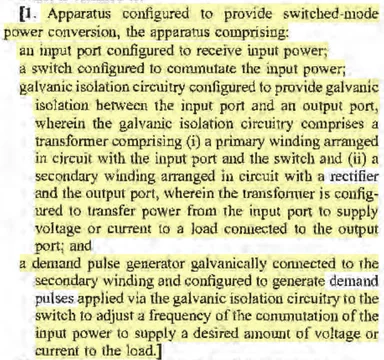
New Judge Williams is on a roll lately, releasing seven new opinions on Wednesday alone. Sadly we can't post about them all—I'd be doing nothing but writing blog posts. But I wanted to take the opportunity to point out an opinion from a rare (in D. Del., at least) trade secret action.
In Zoppas Industries de Mexico, S.A. v. Backer EHP Inc., C.A. No. 18-1693-GBW (D. Del.), the plaintiff accused the defendant of misappropriating its trade secret information about heating elements for appliances.
According to the complaint, plaintiff disclosed its literal secret plan—the "Zoppas Plan"—to appliance manufacturer Whirlpool. The complaint also alleges that the defendant here, Backer, then acquired that secret plan from Whirlpool and used it to improve its own heating elements.
But the plaintiff apparently found out in discovery that Backer also misappropriated its trade secrets through another third party, named Mabe. Plaintiff claims it had an NDA with Mabe, yet Backer got a "non-public 'sample'" of plaintiff's product from Mabe.
Defendant moved for summary judgment on both of plaintiff's theories. The Court flat-out rejected the idea that plaintiff could assert the new misappropriation theory without amending their complaint, even if the other side was on notice:
[Plaintiff] ZIM attempts to satisfy the misappropriation element by arguing that that Backer "obtain[ed] a non-public 'sample' of Plaintiffs element from Mabe, which owed Plaintiff a contractual duty of non-disclosure." D.I. 133 at 10. But this Court has already ruled Mabe outside the scope of ZIM' s operative complaint, D .I. 98, which pleads a misappropriation theory based on Backer's purported acquisition of a ZIM trade secret from Whirlpool, D.I. 55.
The Court had set forth in a previous order that the claims were unrelated:
The discovery sought by Plaintiff relates to an assertion that Defendant obtained non-public information about Plaintiffs design from a third-party company named Mabe. The claims in Plaintiff's operative complaint do not have anything to do with that allegation; that complaint alleges that Defendant obtained non-public information about Plaintiffs design from a different third-party company Whirlpool). So the discovery sought is not relevant to Plaintiffs current claims and is thus not warranted.
The Court held that plaintiff can't just amend its complaint by way of an answering brief on summary judgment:
If this Court were to condone ZIM's attempt to use Mabe-related evidence to defeat summary judgment on a claim based on Backer's relationship with Whirlpool, the Court would err by permitting ZIM to amend its operative complaint via its opposing brief. . . . Accordingly, the Court will not credit ZIM's Mabe-related evidence as "disputed" material facts precluding the entry of summary judgment. . . . By failing to amend its complaint, ZIM has waived its claim related to Mabe.
Ouch. It's unclear why, despite the Court's earlier warning, plaintiff did not at least attempt to amend their complaint.
That's Not How It Works in the Patent World
This is particularly interesting for patent practitioners. The regular practice in the patent realm is that a new theory of infringement, a new accused product, or even new asserted patent claims do not require amending the complaint. It's worth keeping in mind that the same may not be true of new trade secret misappropriation theories.
You Can't Rely on Speculation to Survive SJ
The Court also granted summary judgment on their other, Whirlpool-based theory, finding that it was unsupported by direct evidence, and the circumstantial evidence wasn't enough to survive summary judgment:
The United States Court of Appeals for the Third Circuit has explained that "[c]ircumstantial evidence can be used to establish a misappropriation of trade secrets, but only after enough specific information has been given to the accused party so they can defend what it is they are accused of stealing. Inferences drawn from circumstantial evidence cannot be used to substantiate bald assertions." Givaudan Fragrances Corp. v. Krivda, 639 F. App'x 840, 846 (3d Cir. 2016).
The problem was that the relevant communications occurred after the product was public domain:
Here, ZIM has not identified what specific "more than sufficient" circumstantial evidence would create a genuine issue for trial on whether Backer acquired a ZIM trade secret from Whirlpool-a burden that is ZIM's to bear. . . . Setting aside unrelated Mabe evidence, ZIM cites only to deposition testimony that Whirlpool told Backer that "Zoppas' s heating element had a faster speed of heat." . . . . Those communications, however, occurred in late 2018 after ZIM's product was already in the public domain—a fact that ZIM does not dispute. . . .
Beyond that, the defendant designed its product before the alleged misappropriation:
Moreover, in view of the parties' agreement that Backer designed its product in 2017, Backer could not have designed that product based on an awareness of ZIM's faster speed-of-heat obtained in 2018. Indeed, the parties agree that Backer did not begin discussing its product with Whirlpool until after Backer received a signed NDA from Whirlpool on June 6, 2017. . . . By that time, Backer had already designed its product and filed a patent application covering its design. . . . Backer's design was materially complete when it began discussions with Whirlpool and did not materially change before receiving UL approval on March 20, 2018. . . . While ZIM argues that "Backer never stopped trying to improve its speed-of-heat time," . . . none of ZIM's cited testimony supports an inference that Backer did so by acquiring a ZIM trade secret from Whirlpool.
In essence, ZIM has pointed to Backer's desire to improve its speed-of-heat time and has speculatively concluded that Backer must have acquired a ZIM trade secret to do so. Speculation cannot sustain a trade secret misappropriation claim at summary judgment.
I'm honestly unsure what the takeaway is here, other than that you need something more than absolutely unsupported speculation to survive summary judgment in a trade secret action—but that's true of any action, really.
If you enjoyed this post, consider subscribing to receive free e-mail updates about new posts.




